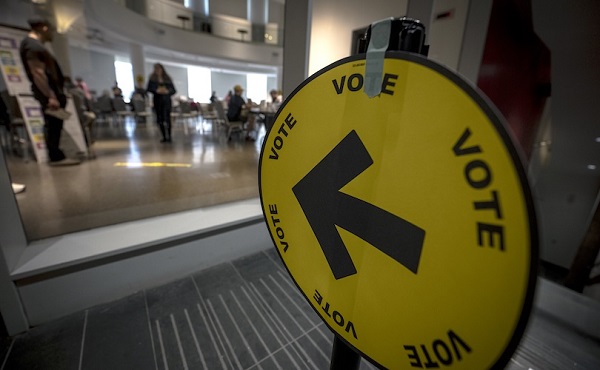Brownstone Institute
EU Digital Identity Wallet Pilots Roll Out Under the Radar

From the Brownstone Institute
BY
As 2023 continues, the European Commission appears busy developing and running pilots for its EU Digital Identity Wallet (EUDI), which it intends to make available to all EU citizens in the near future. But while the European Commission (EC) boasts the prospective EUDI’s convenience, security, and wide range of prospective use cases in daily life, what’s less discussed is the tool’s potential for a bevy of ethical and surveillance-related issues.
What is the EU Digital Identity Wallet (EUDI)?
The EU Digital Wallet, often referred to as the EU Digital Identity Wallet (EUDI), is slated to be offered to the European public in the years ahead. According to the European Commission, “EU Digital Identity Wallets are personal digital wallets allowing citizens to digitally identify themselves, store and manage identity data and official documents in electronic format. These may include a driving licence, medical prescriptions or education qualifications.”
As legislation streamlining their slated use across Europe is finalized, the European Commission is advancing its efforts to roll out EUDIs amongst the general European public, where over 250 private corporations and public authorities are participating in four large-scale pilot projects. At the time of writing, the EU has invested €46 million into these pilots.
Indeed, a wide range of use cases are already being tested in the EUDI pilot projects. These include using the wallets to access government services, register, and activate SIM cards for mobile network services, sign contracts, facilitate travel, and present educational credentials. All together, these use cases suggest the Digital Identity Wallets’ prospective utilization across a wide range of services essential to daily life.
Convenience, But for Whom?
The European Commission frequently plays up the digital wallet’s convenience, with messaging boasting that users will be able to use the Wallets to check into hotels, file tax returns, rent cars, and securely open bank accounts. European Commission President Ursula von der Leyen highlighted the following in a 2020 State of the Union address, where she proposed the concept of a “secure European e-identity:”
Every time an App or website asks us to create a new digital identity or to easily log on via a big platform, we have no idea what happens to our data in reality. That is why the Commission will propose a secure European e-identity. One that we trust and that any citizen can use anywhere in Europe to do anything from paying your taxes to renting a bicycle. A technology where we can control ourselves what data is used and how.
Certainly, von der Leyen is correct that “we have no idea what happens to our data” when we create online accounts or log in to private services, positing that Digital ID can work to solve a core problem many people have when using the internet.
But critically, the European “e-identity,” and digital identification methods generally, pose a bevy of new issues for civilians in both the short and long term. Namely, while Digital ID can provide users access to services, a 2018 WEF report on Digital ID admits the tool’s propensity to exclude; “[f]or individuals, [verifiable IDs] open up (or close off) the digital world, with its jobs, political activities, education, financial services, healthcare and more.”
And indeed, within the control of a corrupted state or other governance structures, Digital ID’s propensity to “close off” the digital world appears ripe for misuse or abuse. Researcher Eve Hayes de Kalaf, for example, writes in the Conversation that “states can weaponise internationally sponsored ID systems” against vulnerable populations. She highlights an example from the Dominican Republic, where long-term discrimination against Haitian-descended persons manifested in the stripping of their Dominican nationality in 2013, rendering them stateless.
Meanwhile, it’s not difficult to imagine others falling through the digital “cracks” as Digital ID systems become mainstream and interconnected with, if not a prerequisite for, accessing critical social and financial services and supports.
As Jeremy Loffredo and Max Blumenthal elucidate in 2021 reporting for the Grayzone, for example, the 2017 introduction of Aadhaar, India’s biometric ID system, “which tracks users’ movements between cities,” led to a spate of deaths in rural India as difficulties accessing the Aadhaar system functionally blocked goods and benefits recipients from accessing the country’s ration stores, leaving them to even starve. India’s Scroll reported that, in a random sampling of 18 villages in India where biometric authentication had been mandated to access government-subsidized food rations, 37 percent of cardholders were unable to obtain their rations.
Despite the devastation it has caused, Aadhaar has ultimately been promoted as a success, and Rest of World reports that India’s setting up international partnerships to export its popular Unified Payments Interface (UPI), an instant payment system which uses the Aadhaar biometric ID system as its base, elsewhere.
Clearly, Digital ID poses significant possible societal harms if implemented hastily. Despite these possible harms, as I note for Unlimited Hangout, a near-universal adoption of Digital ID systems increasingly appears inevitable, with “Juniper Research [estimating] that governments will have issued about 5 billion digital ID credentials by 2024, and a 2019 Goode Intelligence report [suggesting] digital identity and verification will be a $15 billion market by 2024.”
Further, legislative strides have been made towards the digital wallet’s interoperability across the EU. In other words, key services are being hyper-centralized across borders and digitized in ways more traceable than paper counterparts could have been — all at the authorities’ fingertips.
Critically, the EUDI Wallet is apparently slated to connect with or otherwise include financial services, where EU citizens will be able to use their EUDI to open bank accounts and even apply for loans. Further, language from a European Central Bank policy brief on the European Digital Identity Framework suggests that the “EUDI wallet will bring benefits to all the stakeholders of the payment ecosystem” even including “foreseen support for the digital euro.”
While the European Commission’s keen to spotlight the EUDI’s alleged benefits for “the stakeholders of the payment ecosystem,” it appears less eager to discuss the dangers surrounding the plausible, if not likely, linkage of digital identity with money, and especially digital currencies, where elite capacities to track, or even manipulate or block civilians’ abilities to accept or make payments, could be unprecedented.
In short, EU Digital Identity Wallets are slated to be convenient for everyday civilian use. At the same time, these wallets, and other adjacent digital ID systems budding elsewhere, could also be convenient for governments and governance structures looking to surveil, monitor or otherwise manipulate or control critical aspects of citizens’ lives en masse.
The DIIA Connection
Despite its lack of EU member status and war on its hands to boot, Ukraine is involved in the EU Digital Wallet pilots. Namely, as I reported on my Substack, DIIA, Ukraine’s hyper-centralized state-in-a-smartphone app, is assisting the EU Digital Wallet’s rollout. In fact, Ukrainian Minister of Digital Transformation Mykhailo Fedorov highlighted in a Telegram post from July that DIIA representatives had even showed off the DIIA app’s capabilities at the POTENTIAL (Pilots for European Digital Identity Wallet) Consortium this summer.
Notably, many of the EU Digital Wallet’s use cases being tested in the pilots are already reality with Ukraine’s DIIA app. Indeed, Ukrainians use DIIA for a range of day-to-day activities, including to verify their identities to use banking services, hold a variety of digital IDs (such as drivers’ licenses and biometric passports) and even pay certain taxes and access social services for families. Ukraine’s Ministry of Digital Transformation has emphasized its intention to make all public services available online: DIIA is to be the “one-stop-shop” for these services.
And, as I’ve mentioned before in previous reporting for my Substack and Unlimited Hangout, DIIA’s scope creep continues as conflict deepens, with the app providing war-adjacent services. Ukrainian civilians affected by war have received stipendsthrough the app, for example, and can also verify their identities through DIIA to sign into e-Vorog (“e-enemy”), a chatbot that allows Ukrainian citizens to report information about Russian military whereabouts to the state.
All together, these conditions suggest DIIA may serve as a kind of blueprint for or precursor to Europe’s adjacent Digital Wallet, where the EU Digital Wallet, already a centralized application slated to assist citizens in a number of critical day-to-day services, could take on a growing number of government services across the European Union. While it remains to be seen what happens with the Digital Wallet rollouts in Europe, the wallet’s EU-wide implementation and smartphone app format, where features can be easily introduced, removed, or edited at will, means that scope creep on a comparable scale cannot be ruled out.
Conclusion
Many people are understandably interested in digital documents and other easy ways to access public services and complete tasks in a digital age. But these services and tools, when facilitated by states and adjacent governance structures, and unaccountable members of the private sector, come with significant ethical and surveillance concerns that should be extensively discussed and debated by the public. In this respect, it appears the prospective EU Digital Identity Wallet is no exception.
But debate or not, Digital Wallet pilot rollouts and EU member states’ respective Digital ID adoption is ongoing, with an EC press statement explaining that “everyone will have a right to have an EU Digital Identity” accepted in all EU Member States.
And while the European Commission communicates “there will be no obligation” to use an EU Digital ID Wallet, EC report Communication 2030 Digital Compass: The European Way for the Digital Decade elucidates that a 2030 target for the EU is for 80 percent of citizens to use an “electronic identification solution.” Ultimately, the mixed messaging leaves room for speculation that, even if Digital IDs are not obligatory when introduced, the general population could somehow be nudged or eventually even mandated into adopting Digital IDs to access key public services.
While Digital ID proponents emphasize the tools’ capacity for convenience and security in an increasingly online world, the ethical and privacy issues I’ve highlighted here signal that, if rolled out hastily, the EU Digital Identity Wallets could ultimately have disastrous and lasting consequences for privacy and civil liberties. And, once implemented, it seems Digital IDs could be difficult to roll back even if unpopular, ultimately nudging people into a technocratic nightmare they cannot easily escape.
In short, the dangers posed by emerging Digital ID systems like the EUDI Wallet cannot be discounted as Europe grows into its “digital decade.”
Brownstone Institute
Net Zero: The Mystery of the Falling Fertility

From the Brownstone Institute
By
If you want to argue that a mysterious factor X is responsible for the drop in fertility, you will have to explain (1) why the factor affected only the vaccinated, and (2) why it started affecting them at about the time of vaccination.
In January 2022, the number of children born in the Czech Republic suddenly decreased by about 10%. By the end of 2022, it had become clear that this was a signal: All the monthly numbers of newborns were mysteriously low.
In April 2023, I wrote a piece for a Czech investigative platform InFakta and suggested that this unexpected phenomenon might be connected to the aggressive vaccination campaign that had started approximately 9 months before the drop in natality. Denik N – a Czech equivalent of the New York Times – immediately came forward with a “devastating takedown” of my article, labeled me a liar and claimed that the pattern can be explained by demographics: There were fewer women in the population and they were getting older.
To compare fertility across countries (and time), the so-called Total Fertility Rate (TFR) is used. Roughly speaking, it is the average number of children that are born to a woman over her lifetime. TFR is independent of the number of women and of their age structure. Figure 1 below shows the evolution of TFR in several European countries between 2001 and 2023. I selected countries that experienced a similar drop in TFR in 2022 as the Czech Republic.

So, by the end of 2023, the following two points were clear:
- The drop in natality in the Czech Republic in 2022 could not be explained by demographic factors. Total fertility rate – which is independent of the number of women and their age structure – dropped sharply in 2022 and has been decreasing ever since. The data for 2024 show that the Czech TFR has decreased further to 1.37.
- Many other European countries experienced the same dramatic and unexpected decrease in fertility that started at the beginning of 2022. I have selected some of them for Figure 1 but there are more: The Netherlands, Norway, Slovakia, Slovenia, and Sweden. On the other hand, there are some countries that do not show a sudden drop in TFR, but rather a steady decline over a longer period (e.g. Belgium, France, UK, Greece, or Italy). Notable exceptions are Bulgaria, Spain, and Portugal where fertility has increased (albeit from very low numbers). The Human Fertility Project database has all the numbers.
This data pattern is so amazing and unexpected that even the mainstream media in Europe cannot avoid the problem completely. From time to time, talking heads with many academic titles appear and push one of the politically correct narratives: It’s Putin! (Spoiler alert: The war started in February 2022; however, children not born in 2022 were not conceived in 2021). It’s the inflation caused by Putin! (Sorry, that was even later). It’s the demographics! (Nope, see above, TFR is independent of the demographics).
Thus, the “v” word keeps creeping back into people’s minds and the Web’s Wild West is ripe with speculation. We decided not to speculate but to wrestle some more data from the Czech government. For many months, we were trying to acquire the number of newborns in each month, broken down by age and vaccination status of the mother. The post-socialist health-care system of our country is a double-edged sword: On one hand, the state collects much more data about citizens than an American would believe. On the other hand, we have an equivalent of the FOIA, and we are not afraid to use it. After many months of fruitless correspondence with the authorities, we turned to Jitka Chalankova – a Czech Ron Johnson in skirts – who finally managed to obtain an invaluable data sheet.
To my knowledge, the datasheet (now publicly available with an English translation here) is the only officially released dataset containing a breakdown of newborns by the Covid-19 vaccination status of the mother. We requested much more detailed data, but this is all we got. The data contains the number of births per month between January 2021 and December 2023 given by women (aged 18-39) who were vaccinated, i.e., had received at least one Covid vaccine dose by the date of delivery, and by women who were unvaccinated, i.e., had not received any dose of any Covid vaccine by the date of delivery.
Furthermore, the numbers of births per month by women vaccinated by one or more doses during pregnancy were provided. This enabled us to estimate the number of women who were vaccinated before conception. Then, we used open data on the Czech population structure by age, and open data on Covid vaccination by day, sex, and age.
Combining these three datasets, we were able to estimate the rates of successful conceptions (i.e., conceptions that led to births nine months later) by preconception vaccination status of the mother. Those interested in the technical details of the procedure may read Methods in the newly released paper. It is worth mentioning that the paper had been rejected without review in six high-ranking scientific journals. In Figure 2, we reprint the main finding of our analysis.

Figure 2 reveals several interesting patterns that I list here in order of importance:
- Vaccinated women conceived about a third fewer children than would be expected from their share of the population. Unvaccinated women conceived at about the same rate as all women before the pandemic. Thus, a strong association between Covid vaccination status and successful conceptions has been established.
- In the second half of 2021, there was a peak in the rate of conceptions of the unvaccinated (and a corresponding trough in the vaccinated). This points to rather intelligent behavior of Czech women, who – contrary to the official advice – probably avoided vaccination if they wanted to get pregnant. This concentrated the pregnancies in the unvaccinated group and produced the peak.
- In the first half of 2021, there was significant uncertainty in the estimates of the conception rates. The lower estimate of the conception rate in the vaccinated was produced by assuming that all women vaccinated (by at least one dose) during pregnancy were unvaccinated before conception. This was almost certainly true in the first half of 2021 because the vaccines were not available prior to 2021. The upper estimate was produced by assuming that all women vaccinated (by at least one dose) during pregnancy also received at least one dose before conception. This was probably closer to the truth in the second part of 2021. Thus, we think that the true conception rates for the vaccinated start close to the lower bound in early 2021 and end close to the upper bound in early 2022. Once again, we would like to be much more precise, but we have to work with what we have got.
Now that the association between Covid-19 vaccination and lower rates of conception has been established, the one important question looms: Is this association causal? In other words, did the Covid-19 vaccines really prevent women from getting pregnant?
The guardians of the official narrative brush off our findings and say that the difference is easily explained by confounding: The vaccinated tend to be older, more educated, city-dwelling, more climate change aware…you name it. That all may well be true, but in early 2022, the TFR of the whole population dropped sharply and has been decreasing ever since.
So, something must have happened in the spring of 2021. Had the population of women just spontaneously separated into two groups – rednecks who wanted kids and didn’t want the jab, and city slickers who didn’t want kids and wanted the jab – the fertility rate of the unvaccinated would indeed be much higher than that of the vaccinated. In that respect, such a selection bias could explain the observed pattern. However, had this been true, the total TFR of the whole population would have remained constant.
But this is not what happened. For some reason, the TFR of the whole population jumped down in January 2022 and has been decreasing ever since. And we have just shown that, for some reason, this decrease in fertility affected only the vaccinated. So, if you want to argue that a mysterious factor X is responsible for the drop in fertility, you will have to explain (1) why the factor affected only the vaccinated, and (2) why it started affecting them at about the time of vaccination. That is a tall order. Mr. Occam and I both think that X = the vaccine is the simplest explanation.
What really puzzles me is the continuation of the trend. If the vaccines really prevented conception, shouldn’t the effect have been transient? It’s been more than three years since the mass vaccination event, but fertility rates still keep falling. If this trend continues for another five years, we may as well stop arguing about pensions, defense spending, healthcare reform, and education – because we are done.
We are in the middle of what may be the biggest fertility crisis in the history of mankind. The reason for the collapse in fertility is not known. The governments of many European countries have the data that would unlock the mystery. Yet, it seems that no one wants to know.
Author
Brownstone Institute
FDA Exposed: Hundreds of Drugs Approved without Proof They Work

From the Brownstone Institute
By
The US Food and Drug Administration (FDA) has approved hundreds of drugs without proof that they work—and in some cases, despite evidence that they cause harm.
That’s the finding of a blistering two-year investigation by medical journalists Jeanne Lenzer and Shannon Brownlee, published by The Lever.
Reviewing more than 400 drug approvals between 2013 and 2022, the authors found the agency repeatedly ignored its own scientific standards.
One expert put it bluntly—the FDA’s threshold for evidence “can’t go any lower because it’s already in the dirt.”
A System Built on Weak Evidence
The findings were damning—73% of drugs approved by the FDA during the study period failed to meet all four basic criteria for demonstrating “substantial evidence” of effectiveness.
Those four criteria—presence of a control group, replication in two well-conducted trials, blinding of participants and investigators, and the use of clinical endpoints like symptom relief or extended survival—are supposed to be the bedrock of drug evaluation.
Yet only 28% of drugs met all four criteria—40 drugs met none.
These aren’t obscure technicalities—they are the most basic safeguards to protect patients from ineffective or dangerous treatments.
But under political and industry pressure, the FDA has increasingly abandoned them in favour of speed and so-called “regulatory flexibility.”
Since the early 1990s, the agency has relied heavily on expedited pathways that fast-track drugs to market.
In theory, this balances urgency with scientific rigour. In practice, it has flipped the process. Companies can now get drugs approved before proving that they work, with the promise of follow-up trials later.
But, as Lenzer and Brownlee revealed, “Nearly half of the required follow-up studies are never completed—and those that are often fail to show the drugs work, even while they remain on the market.”
“This represents a seismic shift in FDA regulation that has been quietly accomplished with virtually no awareness by doctors or the public,” they added.
More than half the approvals examined relied on preliminary data—not solid evidence that patients lived longer, felt better, or functioned more effectively.
And even when follow-up studies are conducted, many rely on the same flawed surrogate measures rather than hard clinical outcomes.
The result: a regulatory system where the FDA no longer acts as a gatekeeper—but as a passive observer.
Cancer Drugs: High Stakes, Low Standards
Nowhere is this failure more visible than in oncology.
Only 3 out of 123 cancer drugs approved between 2013 and 2022 met all four of the FDA’s basic scientific standards.
Most—81%—were approved based on surrogate endpoints like tumour shrinkage, without any evidence that they improved survival or quality of life.
Take Copiktra, for example—a drug approved in 2018 for blood cancers. The FDA gave it the green light based on improved “progression-free survival,” a measure of how long a tumour stays stable.
But a review of post-marketing data showed that patients taking Copiktra died 11 months earlier than those on a comparator drug.
It took six years after those studies showed the drug reduced patients’ survival for the FDA to warn the public that Copiktra should not be used as a first- or second-line treatment for certain types of leukaemia and lymphoma, citing “an increased risk of treatment-related mortality.”
Elmiron: Ineffective, Dangerous—And Still on the Market
Another striking case is Elmiron, approved in 1996 for interstitial cystitis—a painful bladder condition.
The FDA authorized it based on “close to zero data,” on the condition that the company conduct a follow-up study to determine whether it actually worked.
That study wasn’t completed for 18 years—and when it was, it showed Elmiron was no better than placebo.
In the meantime, hundreds of patients suffered vision loss or blindness. Others were hospitalized with colitis. Some died.
Yet Elmiron is still on the market today. Doctors continue to prescribe it.
“Hundreds of thousands of patients have been exposed to the drug, and the American Urological Association lists it as the only FDA-approved medication for interstitial cystitis,” Lenzer and Brownlee reported.
“Dangling Approvals” and Regulatory Paralysis
The FDA even has a term—”dangling approvals”—for drugs that remain on the market despite failed or missing follow-up trials.
One notorious case is Avastin, approved in 2008 for metastatic breast cancer.
It was fast-tracked, again, based on ‘progression-free survival.’ But after five clinical trials showed no improvement in overall survival—and raised serious safety concerns—the FDA moved to revoke its approval for metastatic breast cancer.
The backlash was intense.
Drug companies and patient advocacy groups launched a campaign to keep Avastin on the market. FDA staff received violent threats. Police were posted outside the agency’s building.
The fallout was so severe that for more than two decades afterwards, the FDA did not initiate another involuntary drug withdrawal in the face of industry opposition.
Billions Wasted, Thousands Harmed
Between 2018 and 2021, US taxpayers—through Medicare and Medicaid—paid $18 billion for drugs approved under the condition that follow-up studies would be conducted. Many never were.
The cost in lives is even higher.
A 2015 study found that 86% of cancer drugs approved between 2008 and 2012 based on surrogate outcomes showed no evidence that they helped patients live longer.
An estimated 128,000 Americans die each year from the effects of properly prescribed medications—excluding opioid overdoses. That’s more than all deaths from illegal drugs combined.
A 2024 analysis by Danish physician Peter Gøtzsche found that adverse effects from prescription medicines now rank among the top three causes of death globally.
Doctors Misled by the Drug Labels
Despite the scale of the problem, most patients—and most doctors—have no idea.
A 2016 survey published in JAMA asked practising physicians a simple question—what does FDA approval actually mean?
Only 6% got it right.
The rest assumed that it meant the drug had shown clear, clinically meaningful benefits—such as helping patients live longer or feel better—and that the data was statistically sound.
But the FDA requires none of that.
Drugs can be approved based on a single small study, a surrogate endpoint, or marginal statistical findings. Labels are often based on limited data, yet many doctors take them at face value.
Harvard researcher Aaron Kesselheim, who led the survey, said the results were “disappointing, but not entirely surprising,” noting that few doctors are taught about how the FDA’s regulatory process actually works.
Instead, physicians often rely on labels, marketing, or assumptions—believing that if the FDA has authorized a drug, it must be both safe and effective.
But as The Lever investigation shows, that is not a safe assumption.
And without that knowledge, even well-meaning physicians may prescribe drugs that do little good—and cause real harm.
Who Is the FDA Working for?
In interviews with more than 100 experts, patients, and former regulators, Lenzer and Brownlee found widespread concern that the FDA has lost its way.
Many pointed to the agency’s dependence on industry money. A BMJ investigation in 2022 found that user fees now fund two-thirds of the FDA’s drug review budget—raising serious questions about independence.

Yale physician and regulatory expert Reshma Ramachandran said the system is in urgent need of reform.
“We need an agency that’s independent from the industry it regulates and that uses high-quality science to assess the safety and efficacy of new drugs,” she told The Lever. “Without that, we might as well go back to the days of snake oil and patent medicines.”
For now, patients remain unwitting participants in a vast, unspoken experiment—taking drugs that may never have been properly tested, trusting a regulator that too often fails to protect them.
And as Lenzer and Brownlee conclude, that trust is increasingly misplaced.
- Investigative report by Jeanne Lenzer and Shannon Brownlee at The Lever [link]
- Searchable public drug approval database [link]
- See my talk: Failure of Drug Regulation: Declining standards and institutional corruption
Republished from the author’s Substack
-

 Education1 day ago
Education1 day agoWhy more parents are turning to Christian schools
-

 Immigration2 days ago
Immigration2 days agoUnregulated medical procedures? Prince Edward Islanders Want Answers After Finding Biomedical Waste From PRC-Linked Monasteries
-

 Business2 days ago
Business2 days agoDemocracy Watchdog Says PM Carney’s “Ethics Screen” Actually “Hides His Participation” In Conflicted Investments
-

 Alberta1 day ago
Alberta1 day agoUpgrades at Port of Churchill spark ambitions for nation-building Arctic exports
-

 Addictions2 days ago
Addictions2 days agoAfter eight years, Canada still lacks long-term data on safer supply
-

 Alberta1 day ago
Alberta1 day agoOPEC+ is playing a dangerous game with oil
-

 Business1 day ago
Business1 day agoIs dirty Chinese money undermining Canada’s Arctic?
-

 National2 days ago
National2 days agoLiberals push to lower voting age to 16 in federal elections







